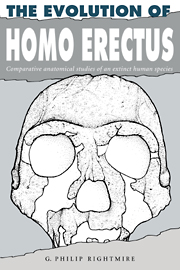Book contents
- Frontmatter
- Contents
- Preface
- 1 Introduction
- 2 Homo erectus in the Far East
- 3 Homo erectus at Olduvai Gorge
- 4 Discoveries from the Turkana basin and other localities in sub-Saharan Africa
- 5 Northwest Africa
- 6 Comparisons of African hominids with Asian Homo erectus
- 7 Homo erectus as a paleospecies
- 8 The transition to more modern forms
- 9 Summary and prospects for further research
- References
- Author index
- Subject index
Preface
Published online by Cambridge University Press: 14 October 2009
- Frontmatter
- Contents
- Preface
- 1 Introduction
- 2 Homo erectus in the Far East
- 3 Homo erectus at Olduvai Gorge
- 4 Discoveries from the Turkana basin and other localities in sub-Saharan Africa
- 5 Northwest Africa
- 6 Comparisons of African hominids with Asian Homo erectus
- 7 Homo erectus as a paleospecies
- 8 The transition to more modern forms
- 9 Summary and prospects for further research
- References
- Author index
- Subject index
Summary
My enthusiasm for Homo erectus dates from 1977, when I began the task of preparing anatomical descriptions for several of the crania from Olduvai Gorge. After working on the fine braincase from LLK in Bed II, I decided to review all of the Olduvai fossils that might be representative of the same species. Inevitably, this led to comparisons of the Olduvai crania and jaws with other East African specimens and later with the mandibles from Ternifine in northwest Africa. By 1980, it was clear that the project would go beyond Africa and grow into much more than a monograph on the Olduvai remains. After spending several months in Indonesia in 1981, I reorganized all of the notes that were accumulating, so as to make the Asian record a principal focus of research. Slowly, the book assumed its present outline, in which the famous Java finds are treated first, followed by a systematic survey of all the other fossils attributed to Homo erectus. The Middle Pleistocene material from Europe will be conspicuous by its absence. The complete cranium from Petralona and the Arago specimens are not included in my roster of Homo erectus, but I have brought them into a later part of my discussion, along with other Middle Pleistocene hominids from Africa. To this extent, the book tracks the transition from Homo erectus to a more advanced form of human. How this change occurred is certainly one of the more challenging questions facing paleoanthropologists.
- Type
- Chapter
- Information
- The Evolution of Homo ErectusComparative Anatomical Studies of an Extinct Human Species, pp. ix - xiiPublisher: Cambridge University PressPrint publication year: 1990

